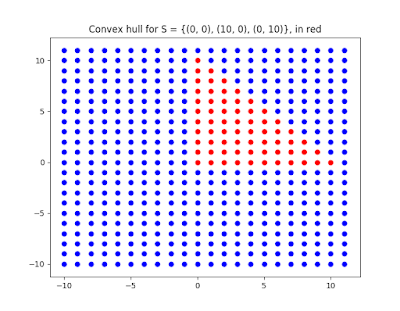Representation
We are given N points. Without loss of generality, they can be represented as the integers 0..N-1. How to represent the solution? One option is to see the problem of finding the best path as selecting N edges from the complete graph with N vertices, under constraints that the edges need to form a path. This representation is good for a MIP approach, but not for more specialized TSP solving. I did write a MIP model for TSP, but with CBC it can only solve instances with about 7 nodes, within 10 seconds. 10 nodes take over a minute, which makes MIP uninteresting as an approach.
A smarter representation comes from thinking that we want to return the elements sorted in a certain order. We could use an array list for this, and slices could perhaps be manipulated efficiently. But a linked list just seems more natural.
 |
| Example TSP with solution |
 |
| The used representation: a dict G with N key-value pairs. In this case, G[u] = v. |
The Triple Switch
The triple switch is really neat. It involves three edges. Two edges are cut, thus separating a segment from the path. The gap is closed with an edge. A third edge is cut. The segment is spliced in to the resulting gap by creating two new edges. This is one way of seeing it! In fact, the three cut edges define three distinct paths. The way they are connected to each other is cycled.
 |
| The before & after of the triple switch. |
Note that this requires that the nodes are oriented as in the picture, otherwise the graph becomes disconnected.
The Cross Switch
The Cross Switch
The cross switch is meant to take two edges that cross each other and replace them with two edges that do not cross each other. This will make the total path shorter (can be shown by using the triangle inequality on a 4-corner convex polygon).
The cross switch can also be written quite neatly:
Ruin & Recreate
Ruin & Recreate is quite a popular principle for solving TSP in practice. The basic operation is: select some subset of the nodes, for example a cluster, and remove all their incident edges. That is the ruin step. In the recreate step, solve TSP with the ruined nodes only, under the constraint that they must link up to the existing path. It was described in [1].
References
[1] Schrimpf, Gerhard, et al. "Record breaking optimization results using the ruin and recreate principle." Journal of Computational Physics 159.2 (2000): 139-171.
 |
| The three steps of the cross switch. 1) crossing edges switch heads. 2) change direction of one of the loops. 3) switch heads again. |
The cross switch can also be written quite neatly:
Ruin & Recreate
Ruin & Recreate is quite a popular principle for solving TSP in practice. The basic operation is: select some subset of the nodes, for example a cluster, and remove all their incident edges. That is the ruin step. In the recreate step, solve TSP with the ruined nodes only, under the constraint that they must link up to the existing path. It was described in [1].
References
[1] Schrimpf, Gerhard, et al. "Record breaking optimization results using the ruin and recreate principle." Journal of Computational Physics 159.2 (2000): 139-171.




















